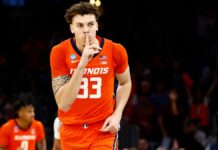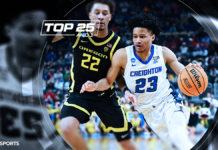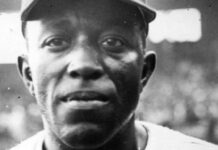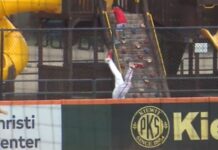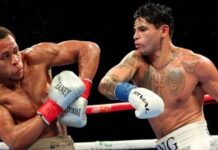There’s an old adage in basketball, especially for younger players who are still developing and learning the game: “Make your free throws.” There’s often an unspoken implication, if not a direct line drawn, from missed free throws at the end of a game to a loss.
The national championship game in the 2008 NCAA tournament could be attached as Appendix A to that basketball life lesson. In the first time since the NCAA Division I men’s basketball tournament expanded to 64 teams, and later 68, all four No. 1 seeds made the Final Four in 2008. Kansas and North Carolina. Memphis and UCLA.
The Jayhawks and Tigers met in the national championship game, the four best teams in the country whittled down to the two best, and Memphis held a 62-60 lead when star freshman Derrick Rose went to the free throw line with 10.8 seconds remaining.
Memphis, then a one-loss team that had marched through some of college athletics’ biggest brands in the NCAA tournament — Michigan State, Texas and UCLA — before having almost every game that season later vacated, could have gone up by four points, a two-possession lead, with just a handful of heartbeats remaining.
“Rose has made his last 13, going back to Saturday’s game, at the line,” CBS play-by-play man Jim Nantz said as Rose stood at the line before the point guard’s two attempts, which could soon open the legendary broadcaster up to accusations of the ol’ announcer’s jinx. Rose was a 71.1-percent free throw shooter, a percent that had slowly climbed due to his recent success at the stripe. He made his first two attempts against Kansas after having made his last 11 against UCLA in the Final Four.
LATEST RANKINGS: AP Top 25 poll | NET rankings | Andy Katz’s Power 36
Kansas coach Bill Self called the team’s final timeout before Rose’s first attempt, giving Rose even longer to ponder his opportunity of doubling his team’s lead. Rose caught the bounce pass from an official, re-gripped the ball slightly so that the ball’s logo was parallel with the end line and he brought the ball all the way over and behind his head with both hands as part of his routine.
He dribbled four times, his right foot about a half-step ahead of his left. The ball rimmed out, bounced off the backboard, then fell off the rim for good. Still 82-80, Memphis.
“It’s called pressure,” Nantz said. “He’s got one more. Kansas, at the very least, will have a shot to tie it, with 10.8 seconds.”
Rose sank the second.
Now, Kansas, having made just two 3-pointers in the first 59 minutes and 49.2 seconds of the game, needed to increase its 3-point output by 50 percent in order to force overtime. Rose picked up Kansas point guard Sherron Collins full-court, but a high-arcing crossover dribble with about 8.2 seconds left allowed Collins to get a step on the Memphis guard, who was trying to prevent his missed free throw from coming back to haunt the Tigers.
Collins crossed halfcourt with seven seconds left, where he ran past the 2008 Final Four logo in which the words “Final Four” were donning a cowboy hat in honor of the host city, San Antonio. Rose, giving pursuit, and Collins, a player who’s five inches shorter, appeared to bump shoulders — not enough for a foul call, although Rose did put up both hands as if to avoid tempting the officials and their whistles.
RANKING LEGENDARY COACHES’ BEST TEAMS: Mike Krzyzewski | Roy Williams | Jim Boeheim | Bill Self
Collins nearly lost control of the ball, which almost escaped his reach, but he was able to corral it — a fitting verb for a play in San Antonio, not too far from a logo featuring an oversized cowboy hat — and he shoveled a pass to teammate Mario Chalmers on the right wing with 5.4 seconds left before falling to the ground.
Chalmers caught the pass around eye level, took one purposeful dribble to his left and elevated to shoot with about 4.2 seconds remaining. Rose had switched onto Chalmers after Collins had crashed to the ground, but Rose was a hair slow, as Chalmers was already into his shooting motion by the time Rose had started to contest the shot.
The ball left Chalmers’ hands with about four seconds left on the clock, with the athletic Rose’s right arm fully extended.
“Collins, driving, almost lost the handle,” Nantz said. “Chalmers, for the tie. Got it, with two seconds! Unbelievable!“
It was a pure swish, one of those shots where the net seems to crack with joy, but quickly returns to form because of the laws of gravity and motion.
The score read 63-63, but the game wasn’t over. No, far from it. There were still 2.1 seconds left on the clock, enough time for Memphis to potentially answer with one of the greatest March Madness moments ever, if the next shot were to find its way through the cylinder.
Memphis’ Antonio Anderson took the ball out of bounds, passed the ball about 40 feet to Robert Dozier, who took one dribble and heaved the ball from halfcourt.
“Dozier, at midcourt, for the championship!” Nantz exclaimed.
If the shot went in, it likely would’ve been the longest game-winning buzzer-beater in March Madness history at the time, probably just edging out U.S. Reed’s half-court game-winner in the second round of the 1981 NCAA tournament.
The ball bounced high off the glass, but never had any intention of going in. The final buzzer of regulation sounded, Nantz yelled, “No!” and the game went to overtime, where Kansas scored the first six points and outscored Memphis 12-5. Chalmers finished with 18 points in the game, none bigger than the three that allowed Kansas to win its third men’s basketball national championship and its first in 20 years.
Below you can watch a full replay of the 2008 national championship game.
NCAA VIDEO VAULT: UMBC’s historic 16-over-1 upset | Northern Iowa’s game-winning buzzer-beater























